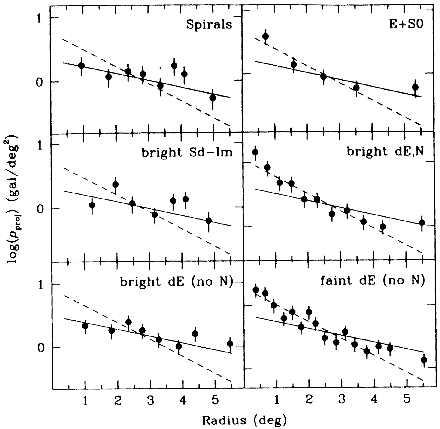


Dwarf ellipticals are the most numerous galaxy type in clusters of galaxies, if cluster members are counted to sufficiently faint magnitudes. Detailed studies of the projected distribution of dE's so far exist only for the nearby Virgo and Fornax clusters (Binggeli et al. 1987; Ferguson and Sandage 1989). Binggeli et al. (1987) have qualitatively shown that nucleated dE's follow the strongly clustered distribution of E's, with non-nucleated dE's being slightly more spread out. This difference between dE,Ns and normal dE's was noted before by van den Bergh (1986), but a later study (Ichikawa et al. 1988) denied the statistical significance of the effect. However, by differentiating their dwarf sample with respect to luminosity, Ferguson and Sandage (1989) did find a significant difference in the distribution of nucleated dE's and bright (MB < - 14.2) non-nucleated dE's, reproduced here in Fig. 8. The latter follow the shallow cluster profile of spirals and irregulars, hinting at a possible evolutionary link between bright dE's (no N) and late-type galaxies (Sect. 7.6). It has also been suggested that the nuclear strength of dE,Ns might correlate with environmental density (Binggeli et al. 1987, p.259, footnote), but this has never been assessed quantitatively.

Figure 8. The projected density of galaxies as a function of radius in the Virgo cluster. The solid line shows the best-fit exponential to the bright non-nucleated dE distribution; the dotted line shows the best fit to the faint non-nucleated dE distribution. Note how the bright non-nucleated dE's follow the distribution of late-type cluster members. The effect is also seen in the Fornax cluster. From Ferguson and Sandage 1989. |
Otherwise, the dE population of the Virgo cluster seems well mixed. The
only significant correlation between photometric and environmental parameters
found by
Ichikawa et
al. (1988)
is that dE's in the
central (r  5°) cluster
region are slightly larger and brighter
than those outside (r > 5°). This mixed state does not, however,
mean that all dwarf ellipticals are freely floating in the cluster potential.
Ferguson
(1992b) has statistically shown that roughly 7% of all
Virgo cluster
galaxies are bound companions, i.e. are gravitationally bound to a more massive
neighbor. By virtue of their overall predominance in the cluster, the
majority of companions (66%, or about 80) are dwarf ellipticals. The
primaries tend to be massive, early-type galaxies. Similar conclusions
have been reached by
Giovanardi and
Binggeli (1991)
and Binggeli (1993).
As expected from the tidal influence by the primaries, the mean
surface brightnesses of the dE companions are marginally (
5°) cluster
region are slightly larger and brighter
than those outside (r > 5°). This mixed state does not, however,
mean that all dwarf ellipticals are freely floating in the cluster potential.
Ferguson
(1992b) has statistically shown that roughly 7% of all
Virgo cluster
galaxies are bound companions, i.e. are gravitationally bound to a more massive
neighbor. By virtue of their overall predominance in the cluster, the
majority of companions (66%, or about 80) are dwarf ellipticals. The
primaries tend to be massive, early-type galaxies. Similar conclusions
have been reached by
Giovanardi and
Binggeli (1991)
and Binggeli (1993).
As expected from the tidal influence by the primaries, the mean
surface brightnesses of the dE companions are marginally ( 0.3 mag)
higher than those of free-floating dE's
(Ferguson 1992b).
Binggeli (1993)
identified some of the bright probable companions of the first and
second ranked Virgo cluster
members, M49 and M87, as inferred from the supposed (dark halo)
masses of the primaries.
0.3 mag)
higher than those of free-floating dE's
(Ferguson 1992b).
Binggeli (1993)
identified some of the bright probable companions of the first and
second ranked Virgo cluster
members, M49 and M87, as inferred from the supposed (dark halo)
masses of the primaries.